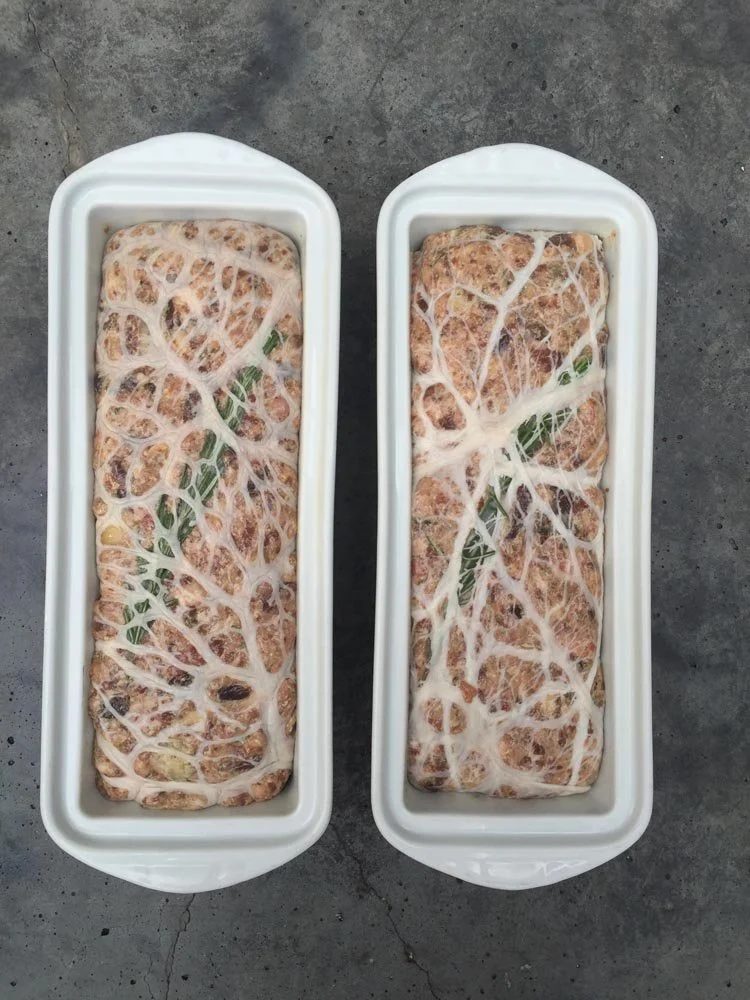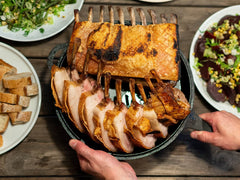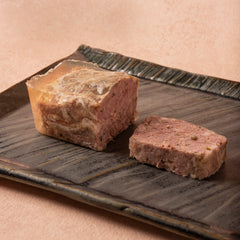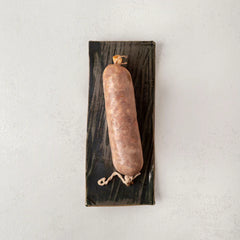What is Pâté?
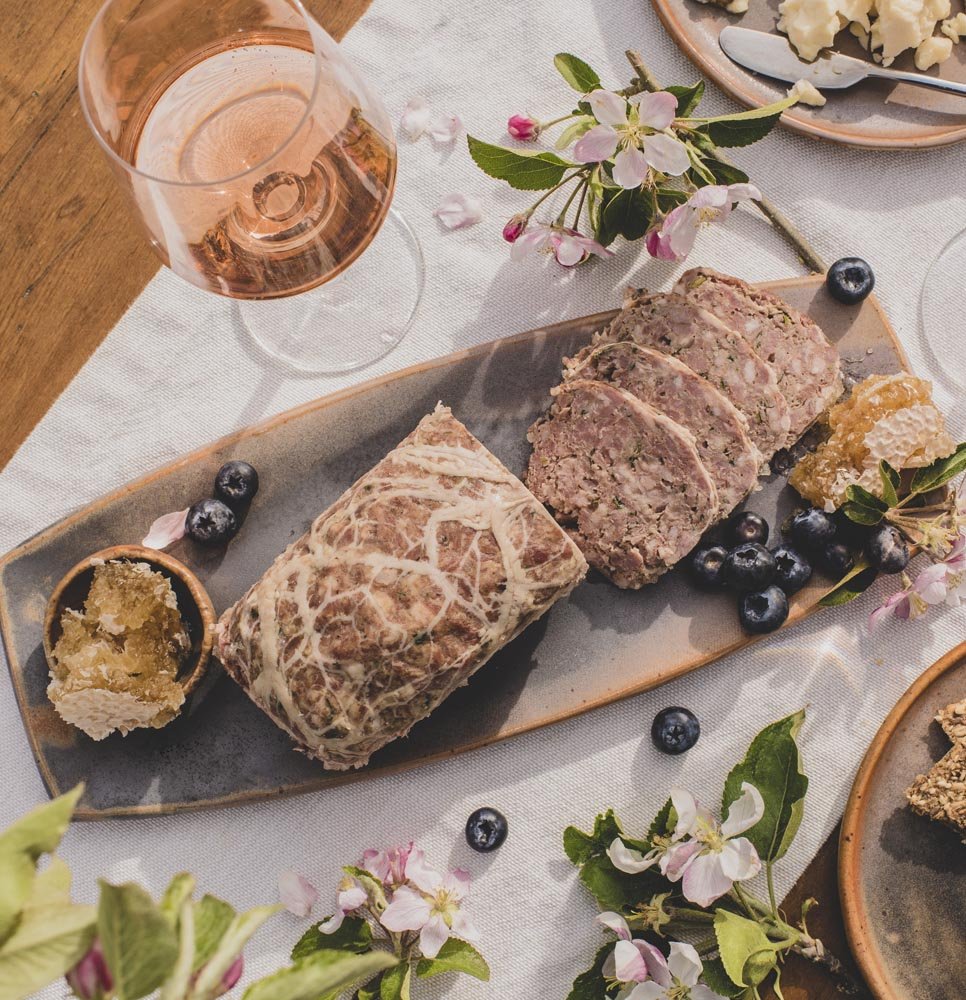
Pâté in French means "paste" which denotes a culinary preparation made of ground meat or fish with different seasonings.
Since its origin in France, pâté is primarily categorized into two types: pâté en croûte, which is baked inside a pastry dough, and crustless pâté en terrine (cooked inside a mold).
The creation of this palatable dish involves finely chopped meat or fish alongside a collection of fresh herbs, spices, and vegetables. Ground meats such as chicken, pork, beef, livers or game meats are the most used to craft pâté. Nuts, dried fruits, black truffle and foie gras can also make a beautiful and delicious addition to any pâté recipe.
The finished product is a velvety, smearable paste that, depending on the recipe, can be served hot or chilled, with fresh bread, pickles and a side salad.
What are the characteristics of pâté?
Pâté can have a coarse, chopped texture or a smooth consistency. The meat mixture is seasoned with various herbs, spices, garlic, onions, shallots or vegetables and even alcohol can be incorporated like red and white wine or brandy. Some other kinds of pâté like the headcheese or fish terrine will be made with aspic. It is a savory jelly typically made from meat or fish stock that has been boiled long enough to release natural gelatin and will be used to set all of the ingredients together once chilled.
How to eat pâté?
Consider it a simple pleasure! Enjoy crustless pâté as part of a charcuterie board with mustard, jam, and pickled vegetables such as cornichons or a simple vinegary green salad. It can also be served as an appetizer alongside a lettuce salad before your main course. And we also recommend serving it on bread or fresh baguette with pickles. It makes a wonderful snack for a road trip or picnic.
To elevate your culinary experience and make it a bit fancier, enjoy Chef Dufour’s award-winning Pâté en Croûte, a tasty pâté inside a cooked pastry dough! You would usually consume it sliced at room temperature with a full-bodied glass of red wine and a side salad.
What type of meat is used to make pâté?
Traditionally in the Middle-Ages, pâté was baked and covered with a pastry dough which was not edible but meant to extend the product shelf life. Back then, it was made mostly with game meat like rabbit, pheasant, venison, pigeon, lamb, etc. Over time, other meats have been used including beef, duck, pork, and capon. In addition to the liver, other parts of the animal, such as the heart, kidneys, head and tongue are used in some pâté recipes. Over the years, the dough has become part of the recipe and is used to make beautiful designs as an art piece.
The choice of meat used in pâté can significantly influence its flavor and texture. For example, chicken liver pâté tends to be smooth and spreadable, while a game pâté may be more robust and coarse. The balance of lean meats and fat in a recipe is very important as it will define its texture and flavor profile.
How is pâté made?
Pâté is made in several steps. First you need to select your meat and grind it finely or coarsely. The ground meat is then mixed with a selection of spices, aromatic herbs, vegetables, foie gras, black truffle and even spirits. Occasionally depending on the recipe, a “panade” is added to the grind preparation. It is a mixture of bread and milk which helps to bind all ingredients together. Finally, the mixture is placed in a terrine mold, wrapped with caul fat and cooked in the oven.
Despite being able to be consumed warm or cold, it is widely recognized that pâté acquires its most magnificent flavors after being chilled for a few days. Just like a stew is always tastier the next day!
Types of pâté
| Types of Pâté | Ingredients | Description |
| Pâté Chaud | Puff pastry, pork, chicken, herbs | Pâté Chaud is a savory pastry filled with a flavorful mix of pork, chicken, and herbs, enclosed in flaky puff pastry. |
| Pâté de Campagne | Pork, liver, garlic, herbs | A rustic country-style pâté made with a blend of pork, liver, garlic, and fragrant herbs, offering a hearty and traditional taste. |
| Pâté en Croûte | Various meats, pastry crust | Pâté en Croûte is an elegant pâté encased in a crisp pastry crust, often featuring a medley of meats for a rich and sophisticated flavor. |
| Pâté de Gibiers | Game meats (venison, wild boar), juniper berries | This pâté showcases the bold flavors of game meats like venison and wild boar, heightened by the aromatic touch of juniper berries. |
| Pâté Grand-mère | Chicken liver, brandy, onions | A classic "Grandmother's pâté" made with chicken liver, brandy, and caramelized onions, offering a comforting and traditional taste. |
| Pâté de Canard | Duck, pork fat, cognac | This pâté features the rich and succulent flavors of duck, complemented by the indulgent addition of pork fat and a hint of cognac. |
| Pâté Forestier | Wild mushrooms, chicken livers, herbs | Pâté Forestier combines the earthy goodness of wild mushrooms with the velvety texture of chicken livers, creating a delightful forest-inspired delicacy. |
| Pâté de Lapin | Rabbit, pork, white wine | A delectable pâté made with tender rabbit meat, pork, and a splash of white wine, resulting in a refined and flavorful dish. |
| Pâté de Poisson | Fish, cream, herbs | Pâté de Poisson offers a lighter option, featuring a blend of fish, cream, and herbs for a refreshing and seafood-infused taste. |
| Pâté de Veau | Veal, pistachios, thyme | Indulge in the delicate flavors of veal accented by the crunch of pistachios and the aromatic touch of thyme in this exquisite pâté. |
Pâté Chaud:
The most famous warm pâté is the pâté Lorrain. It is made with a mix of pork and veal meats that are marinated with white wine, parsley and shallots.The specificity of that recipe is that the dough used is a puff pastry dough which is much more flaky than a regular pastry dough.
Pâté de Campagne:
The most classic French pâté which is mostly made of pork, livers, onions, garlic, and parsley.
Pâté en Croûte:

A pastry shell typically enclosing ground pork, poultry, or game meats combined with various vegetables, nuts, and other ingredients like foie gras or black truffle. Instead of mixing the whole preparation together, some elements are placed on top of each other as layers to give a beautiful outcome when sliced.
Pâté de Gibiers:
Made from farmed animals or wild game (pheasant, roe deer, wild boar or quail) and offers a gamey taste with juicy filling.
Pâté Grand-mère:
This type of pâté is composed of bacon, pork liver and boneless pork leg, flavored with herbs and spices.
Kindly note that all of those categories and recipes can easily vary per the region and local ingredients.
What is the difference between pâté and terrine?
You might have noticed that among pâtés there are also terrines available.
Terrine is an ancient and versatile French dish, which is a combination of cooked ingredients that are arranged in layers in a deep pottery container and then steamed or slow-baked. It can include meat, vegetables, and fish. They can be served hot or cold, and can make a great appetizer or main course. Additionally, terrines are often used in charcuterie boards to complement other dishes like pâté or rillettes.
The difference between pâté and terrine is actually not well defined. There is this saying that pate is made with common meats and terrine with more refined meats like game meat.
Pâté vs Mousse
While pâté offers a fine or coarse texture versus the mousse that will have a fully smooth texture.
Pâté is a rich, savory spread typically made from ground meat or fish, mixed with mainly pork fat, fresh herbs, spices, and occasionally other ingredients like fruits, nuts, or vegetables.
Pâté is often served as an appetizer or snack or spread on a fresh baguette, crackers, or toasted bread. A tasty example is our Pâté Normand created with pork, chicken liver and apples.
Mousse, on the other hand, is a light and airy spread made from poultry and livers combined with cream, butter or other fats. It is usually served as an appetizer or snack and may also be used to top canapés or make sandwiches. In comparison to pâté, mousses are lighter and have a creamy texture.
A classic example is our Chicken Liver Mousse, a smooth elegant spread with buttery flavor that is perfect on bread. The same recipe is also made with black truffles to elevate your Happy Hour!
Whether you prefer the rich and dense texture of different types of pâté or the mousse's light and airy consistency, both will satisfy your cravings for a flavorful spread.
FAQ
What is pâté?
Pâté is a mixture of seasoned ground meat with seasoning, herbs and vegetables that is baked into a terrine and served at room temperature (for most of them). Some pâté are baked inside a pastry dough which is known as pâté en croûte.
What is pâté made of?
Pâté is mainly made from poultry and pork meat, with variations including wild game like partridge, venison, or wild boar, duck, rabbit, or pheasant, and to that is added a mix of spices, herbs, vegetables, foie gras, black truffle or even alcohol. The balance of lean meats and fat in a recipe is very important as it will define its texture and flavor profile.
How is pâté typically eaten?
Pâté is served as an appetizer spread on baguettes, crackers, or toasted bread. It can also be used as a sandwich filling for the perfect snack! There are numerous pâté recipes to satisfy many appetites.
Pâté pairs well with fruit, such as grapes or figs, and is often served with a side of cornichons or other pickled vegetables. It is also frequently paired with red wine.
Remember, when it comes to pâté, the possibilities are endless. Whether you're looking for a mushroom pâté, a pork pâté en croûte, or wild game pâté, there is one for you.
Who knows, you may discover your new favorite pâté dish!
So why not try something new and visit our website today?




